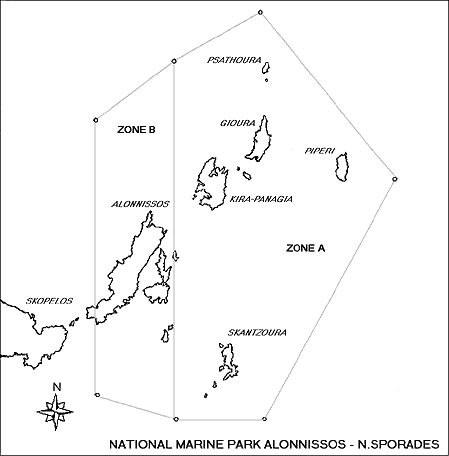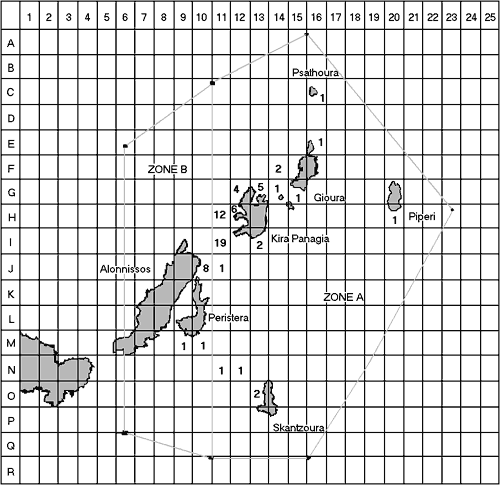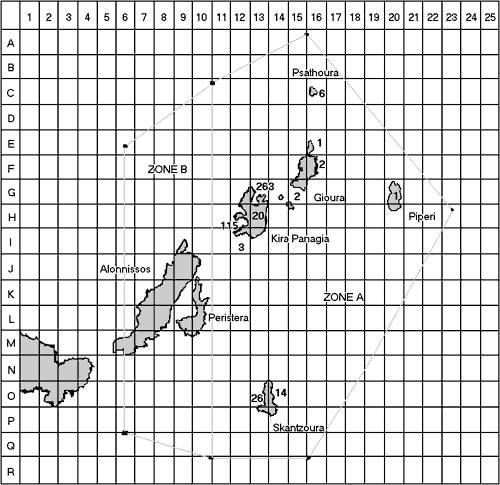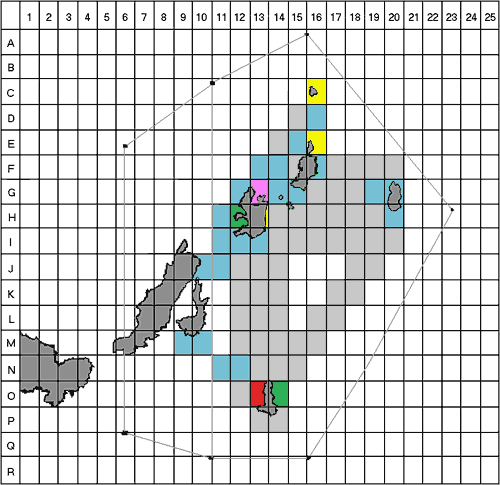| Cave visits
Sixty-nine cave visits were carried out and, in 16 of them, there was evidence of cave use by seals (tracks of movement on the cave beach, blood stains, faeces) (Table 1).
| |
Kira Panagia
|
Gioura
|
Piperi
|
Total
|
| Number of caves surveyed |
1
|
1
|
2
|
4
|
| Caves with evidence of seals |
1
|
1
|
2
|
4
|
| Total number of visits to caves |
17
|
18
|
34
|
69
|
| Number of cases with evidence |
1
|
4
|
11
|
16
|
| % of visits with evidence |
6%
|
22%
|
32%
|
23%
|
Table 1. Cave use by seals in the study area.
For the 4 caves together, the average percentage of evidence of seal presence per survey was 23% (Table 1).
The data collected during this project indicate that the four caves inspected were being used in a different degree by the local seal population (Fig.7).
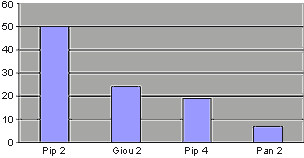
Fig 7: Cave preference recorded during this project
Discussion
The findings of the project allow some tentative conclusions regarding human activity in the National Marine Park of Alonnissos and Northern Sporades. Human activity in the summer months is especially high, mainly due to the presence of tourists in the area, who usually remain in the coastal, non-prohibited waters of the park. Professional fishermen working in the area usually visit the areas prohibited to tourists as well.
Regarding the intensity of human activity in the different Zones of the Park, this project showed the following:
- Zone A: Human activity in this Zone varied from island to island. The reason for the high intensity of human activity in the coastal waters of the islands Kira Panagia and Skantzoura is because of the presence of well protected mooring bays on these islands. The intermediate number of boats per survey registered at the quadrats H13, C16 and E 16 are due to the presence of small natural harbours and the reef area in these quadrats respectively. The legal restrictions imposed on the island of Gioura were usually respected by the tourists visiting the area.
- Core-Zone: Human activity was in all the areas of the Core-Zone minimal and the legal restrictions were generally respected by tourists and fishermen.
The specific pattern of traffic and human activity of the marine areas of the NMPANS presented above, is similar to the activity pattern of previous years (MOm 1995a).
Considering the low number of seals living in the area, the average percentage of seal presence per survey (23%) indicates an intensive cave use by Monachus monachus. The fact that from 16 recorded cases of cave use, only one animal was observed in a cave during the daylight hours, is consistent with the evidence provided by other researchers (Dendrinos et al. 1993, Matsakis et al. 1985) that the monk seal population of the Sporades uses caves mainly at night.
During this project 4 "active" caves at three different islands were monitored. The monk seals showed a preference for the shelters Pip 2, Pip 4 and Giou 2 (Fig. 7). Possible explanations for this apparent shelter preference could be:
1. Human activity in the vicinity of the cave
A comparison between Figures 6 and 7 shows that the caves Pip 2, Giou 2 and Pip 4 of the quadrats H20 and Z16 (quadrats with minimal human activity) were visited more often than the cave Pan 2 at quadrat H12, which is located in an area of intense human activity. Thus, it is logical to assume that monk seals reacted to human activity in the NMPANS and chose undisturbed places to rest at night.
Regarding the low percentage of cave use of Pan 2, one should not suppose that the island of Kira Panagia is not suitable monk seal habitat. While monk seal tracks were not found in Pan 2, evidence of monk seal presence was found in another cave on the same island, which had the same direction of entrance as Pan 2 ( P. Dendrinos and E. Tounda, pers. comm.). According to what is known about monk seal habitat, the latter cave is less suitable than Pan 2, since the substrate of the beach is not as suitable for the seals to rest on. It does offer them, however, better protection against humans, as it has a small, narrow entrance, allowing access to the cave only by swimming whereas Pan 2 has a large entrance and the beach in it is visible from outside. In this case, one might assume that seals in search of solitude and avoidance of humans, would choose such caves during periods of intense human activity. Following the tourist season, they might likewise be expected to return to their "preferred" caves, such as Pan 2. A similar pattern of cave use has been observed in monk seals in the Ionian sea (Panou et al. 1993).
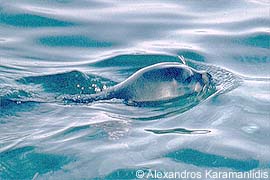
Fig. 8: Juvenile Mediterranean monk seal (Monachus monachus) in the NMPANS
2. Wind force and direction in the vicinity of the cave
‘Human activity’ is, however, insufficient to explain the marked difference in cave use of the other three caves (Pip 2, Pip 4, Giou 2), which are all located in quadrats with minimal human activity. The difference in cave use between Pip 2 (50%) and Pip 4 (19%), which are both located in the same quadrat, is striking.
In search for an explanation for the large difference in cave use between Pip 2 and Pip 4 one must consider the factors of wind, and wave force and direction. The prevailing winds in the Aegean during the summer months are blowing from the North. In this respect cave usage can be explained in two different ways:
- Monk seals use caves independently from the force and direction of the winds. The absence of evidence of use in caves exposed to the prevailing winds is due to the fact that evidence of seal visits is removed by the waves.
- In search of protection against wind and waves, monk seals visit only those caves that can provide them with adequate shelter. For this reason, evidence of cave use can be found only in caves that are not "open" to the prevailing winds.
The research on monk seals in the Sporades by Kouroutos (1987) supports the second hypothesis. Further support is provided by the results obtained from cave-installed automatic cameras. A camera installed in Pip 4, during a period when the winds were blowing continuously from the North, did not record any seal in the cave, whereas cave Pip 2, with an entrance facing to the South, was used twice.
The data presented above suggest that cave preference is dependent on various interrelated factors. Such conclusions, however, must be considered preliminary as they are based on a relatively limited number of visits over a short period of time. Nonetheless, it is known that both cave use and human activity in the Park vary throughout the year (MOm 1995b, MOm 1996).
Acknowledgements
I would like to thank the Hellenic Society for the Study and Protection of the monk seal and especially Mr. V. Zavras for the generous organisational and financial support as well as Mrs. E. Tounta, Mr. P. Dendrinos and Mr. S. Kotomatas for their experienced guidance in the field work. Finally, I wish to express my appreciation to all the numerous persons that helped me writing my thesis and this paper.
References
Dendrinos, P., Tounta, E., Kotomatas, S., Kottas, A. (1993): Recent data on the Mediterranean monk seal population of the North Sporades. Paper submitted to the 6th International Congress on the Zoogeography and Ecology of Greece and Adjacent Regions, Thessaloniki/Greece, April 1993.
Kouroutos, V. (1987): The Mediterranean Monk Seal in the North Sporades National Marine Park, 1982-1987. Thesis for the University of Athens.
Matsakis et al. (1985): Research Programme "North Sporades". Research team of Athens, Athens, December 1985. 1-30.
MOm. (1990): Census and observations of the monk seal population in the National Sea Park of the North Sporades. Summer 1990.
MOm. (1991): Monitoring of the Mediterranean Monk Seal population at the Northern Sporades National Marine Park 1 Nov. 1990 – 31 May 1991. Final report for Contract 6610(90)9/65 of the E.C. and the HSSPMS.
MOm. (1995a): Surveillance and safeguarding of the sensitive area of the Northern Sporades. Final report for the Contract 4-3010(92)7829 between EU and Elliniki Etairia.
MOm. (1995b): Continuation of the monitoring of the monk seals in the National Marine Park of the Northern Sporades. Final report for the Contract 4-3010(92)7829 between EU and Elliniki Etairia.
MOm. (1996): Monk seal conservation in Greece. Part 2. Northern Sporades. A special area of conservation (National Marine Park of Alonissos North Sporades). Final report to the European Commission.
Panou, A., Jacobs, J., Panos, D. (1993): The endangered Mediterranean monk seal Monachus monachus in the Ionian sea, Greece. Biological Conservation 64: 129-140.
Schultze-Westrum, T. 1976. Monk Seal Investigations in Greece. Nature (8): p. 24.
|


